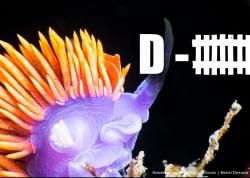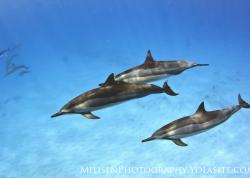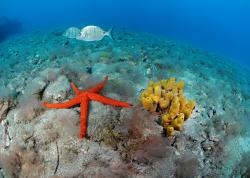Tips to Capture Vibrant Manta Ray Photos

I’ve taken two trips to Socorro, Mexico in the last two years, where I was fortunate enough to have some awe-inspiring encounters with manta rays. Manta rays are in the eagle ray family, and the rays I encountered had an average wingspan of between 18 and 23 feet across. Regardless of manta ray size, there are basic fundamentals that can help you capture great manta ray shots.
Here are some tips to help improve your images:
Use a Smart Approach
The approach should really be more of a non-approach. Sheer photographer instinct and adrenalin will make you want to swim toward the mantas, but here’s where I say “Stop.” Let the manta approach you… for a couple of reasons.
First, it allows them to set the tone for your encounter and allow them to establish their comfort level with you as a diver. Second, it allows you time to position yourself in relation to the sunlight so you don’t lose a great shot because you were too busy swimming toward the mantas, forgetting about the sun’s positioning. I would expand this positioning tip to say, “When possible, separate yourself as much -- and as safely -- as you can from other divers” to help avoid bubbles, a random leg or equipment from other divers ending up in your otherwise perfect shot.


Lighting
In my opinion, the sun is the most important lighting tool when photographing manta rays. The sun serves as a great backlight and can add drama and mystique to any photo. Due to the size of the mantas I swam with, a two-strobe setup is a must, as one strobe can’t handle the job of lighting such a big subject. The strobes will even out the lighting and fill in the shadows, creating a properly lit image.

Lens Choice
This is simple: go as wide as you can (for example: SLR: Tokina 10-17; Compact: any wide-angle wet lens). The wide-angle field of view allows the photographer to fit the scene into the frame and to get as close as possible to the manta. It also helps provide good clarity and allows the strobes to light the subject properly.

Conclusion
Swimming with manta rays is an amazing experience in itself. It’s important to remember that not every image will be perfect every time. I encourage my students to plan, to think and to take a chance in setting up for the right shot. And sometimes, that shot winds up being the perfect shot.
About the Author
 Craig Dietrich is a former Naval and family/children’s photographer. An avid scuba diver, his two loves of diving and photography came together and now Craig is based out of Pompano Beach, Florida. View more of Craig’s work at www.dietrichunderwater.com.
Craig Dietrich is a former Naval and family/children’s photographer. An avid scuba diver, his two loves of diving and photography came together and now Craig is based out of Pompano Beach, Florida. View more of Craig’s work at www.dietrichunderwater.com.
Further Reading
-
Shooting Fast Action Underwater
-
Ultimate Guide to Sea Turtle Photography
-
Kona's Famous Manta Ray Night Dive
-
UWPG Socorro Big Animal Workshop - March 2015
Where to Buy
Please support the Underwater Photography Guide by purchasing your underwater photography gear through our sister site, Bluewater Photo & Video. Click, or call them at (310) 633-5052 for expert advice!
RECOMMENDED ARTICLES
SUPPORT THE UNDERWATER PHOTOGRAPHY GUIDE:
The Best Service & Prices on u/w Photo Gear
 Visit Bluewater Photo & Video for all your underwater photography and video gear. Click, or call the team at (310) 633-5052 for expert advice!
Visit Bluewater Photo & Video for all your underwater photography and video gear. Click, or call the team at (310) 633-5052 for expert advice!
The Best Pricing, Service & Expert Advice to Book your Dive Trips
 Bluewater Travel is your full-service scuba travel agency. Let our expert advisers plan and book your next dive vacation. Run by divers, for divers.
Bluewater Travel is your full-service scuba travel agency. Let our expert advisers plan and book your next dive vacation. Run by divers, for divers.
































